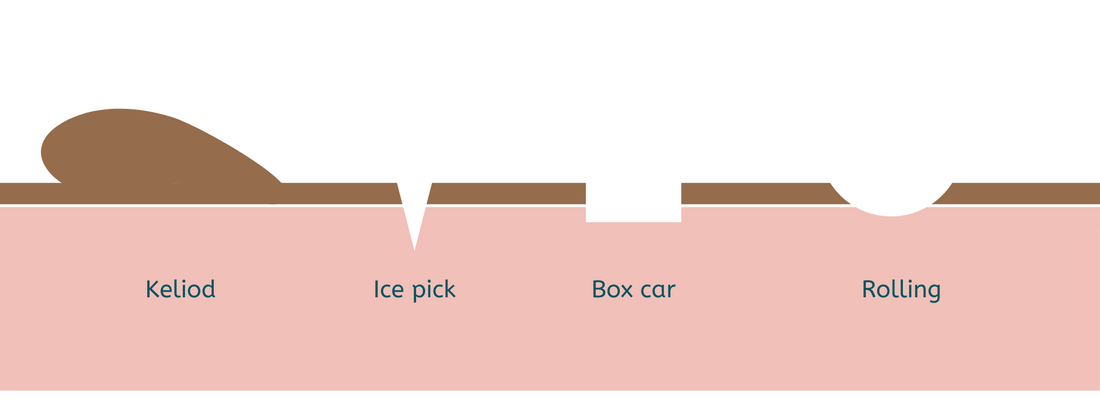
Acne Scars- How to treat every type
Share
Acne scars are annoying and can be difficult and frustrating to get rid of. But to successfully treat acne scars, first you need to understand what type of scar it is. Below, we explain the different types of acne scars, how to prevent them, and how to treat them, according to an expert.
Keloid Scars
If you notice an excessive amount of scar tissue after experiencing acne, you may have keliods.
There are parts of our skin that are more prone to keloids than others. “Often the jawline, back of the neck and chest are more prone to keloids,” says Dr. Gaunche.
Keloids also tend to be genetic, so the condition has likely been passed down from generation to generation.
How They Develop: By constantly picking on your acne, when your skin tries to heal from acne wound it over produces collagen, because the skin doesn't know that the wound has healed, and continues to produce collagen, resulting in a large amount of texture from the inflamed area.
Treating Keliod Scars:
Dr. Gaunche says
- “Sometimes over the counter acne scar pads can be helpful"
- "See a dermatologist’s to inject a diluted form of cortisone called Kenalog into the keloid to help thin out the scar tissue and flatten the keloid,”
- "a pulsed-dye laser called the V-beam is often used to lighten the discoloration"
Ice Pick Scars
Ice pick scars are deep, small and narrow holes that extends into the skin. It can sometimes look like a large, open pore.
How They Develop: you may get it after an infection from a cyst, picking or being abrasive at your acne. This will cause your skin tissue to be destroyed, leaving Ice pick scars.
Treating Ice Pick Scars: you have a few options for treating your scar,
- Use products with retin-A to soften scars and help build collagen
- Punch excision- your doctor uses a tool to glue the skin back together
- Punch grafting- your doctor fills in the hole with skin tissue taken from the body, typically from behind the ear
Boxcar scars
Boxcar scars are round or oval dents in the skin leaving an uneven, rough appearance.
How They Develop: when you breakout and your skin gets inflamed this can destroy the structure (collagen) of the skin. Without this structure the tissue in the skin has no support and the blemished skin is left with dents this is how box scars are formed.
Boxcar scars can be superficial to severe, depending on the amount of tissue lost.
Treating Boxcar Scars: you have a few options for treating your scar,
- Resurfacing lasers such as Fraxel
- Radio-frequency micro-needling
- Dermal fillers can also be helpful in some instances
- EGF (epidermal growth factors), which helps regenerate skin cells
Rolling Scars
Rolling acne scars can be found underneath the skin surface.
How it happens: this is where bands of scar tissue form beneath the layers of the skin’s surface pull at the skin, creating a visible, rolling effect,” Dr. Guanche explains. These scars lose volume and can also become more visible with age.
How to treat:
See a dermatologist, this need to be treated on a deeper level. A resurfacing lasers such as Fraxel mixed with filers for correcting these scars, as they plump up the indented areas.
Buy products to treat acne
